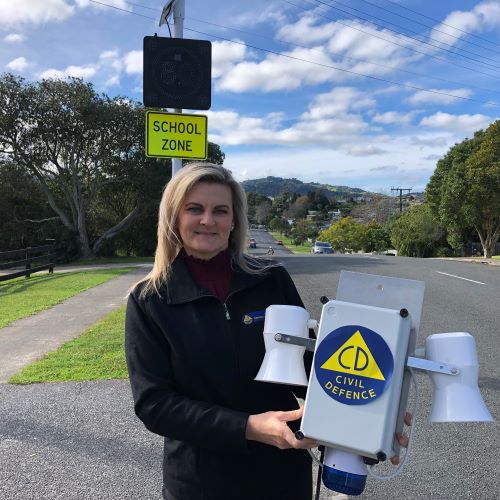New fire alarms leading to confusion with Northland tsunami sirens
16 Jun 2020, 9:22 AM
Northland Civil Defence Emergency Management (CDEM) Group is calling attention to a new generation of building fire alarms which are being installed and sound very similar to the 200-plus tsunami sirens in Northland coastal communities.
There has been an uplift in the number of calls to Northland CDEM from concerned community members as the new fire alarms are installed – mainly in schools to date – and tested.
 Victoria Harwood of Northland CDEM with an example of a Northland tsunami siren. New fire alarms which are being installed in schools in particular sound very similar to the tsunami sirens in Northland coastal communities.
Victoria Harwood of Northland CDEM with an example of a Northland tsunami siren. New fire alarms which are being installed in schools in particular sound very similar to the tsunami sirens in Northland coastal communities.
“In the past, when there’s been confusion, it’s generally been with the ‘air raid’ type sirens used by many volunteer fire brigades,” said Northland CDEM spokesperson Victoria Harwood. “Although these don’t sound at all like tsunami sirens, they are powerful and people who are visiting coastal communities and aren’t familiar with the sound can find them scary, especially in the middle of the night.
“However, the new generation of fire alarms that are being installed do sound very similar to the tsunami sirens. The key way of identifying these new fire alarms is that after four cycles of the sound, there is a voice message telling people to evacuate the building using the nearest fire exit.”
Northland has the most comprehensive network of tsunami sirens in New Zealand, located in in coastal communities from Te Hapua in the north to Mangawhai in the south and Ruawai in the west. The network has been built up since 2010, with the sirens funded and owned by the region’s three district councils (Far North, Whangarei and Kaipara) and operated in a partnership which also includes the two electricity networks (Northpower and Top Energy).
“Our message to Northlanders has always been that the sound of the tsunami sirens is a signal to seek further information – through media, social media, websites and smartphone alerts,” Ms Harwood says. “In the event of a genuine tsunami warning, additional information will be available on the Civil Defence Northland Facebook page, on TV and radio and news media websites and through smartphone alerting platforms (the free Red Cross Hazard app and Emergency Mobile Alerts).”
There is potentially a more permanent solution to the confusion, in the form of a proposal to replace Northland’s existing tsunami sirens with more modern technology. “The first of Northland’s tsunami sirens are now 10 years old. In that time, technology has moved on and there are now options available internationally which have greater reach, and also have a voice component to deliver more detail,’ Ms Harwood says. Replacing or upgrading the sirens has an estimate cost in the millions of dollars and the proposal will be introduced into the long-term planning cycles of Northland’s four councils.
The sounds of the different siren types can be found on this page: www.nrc.govt.nz/sirensounds
The tsunami siren network is tested twice a year, at the beginning and end of daylight savings, which has always been an opportunity for people to re-familiarise themselves with the siren sound. The tests are accompanied by Hazard app messages (as well as advertising and social media publicity). The next test is scheduled for Sunday 27 September.
